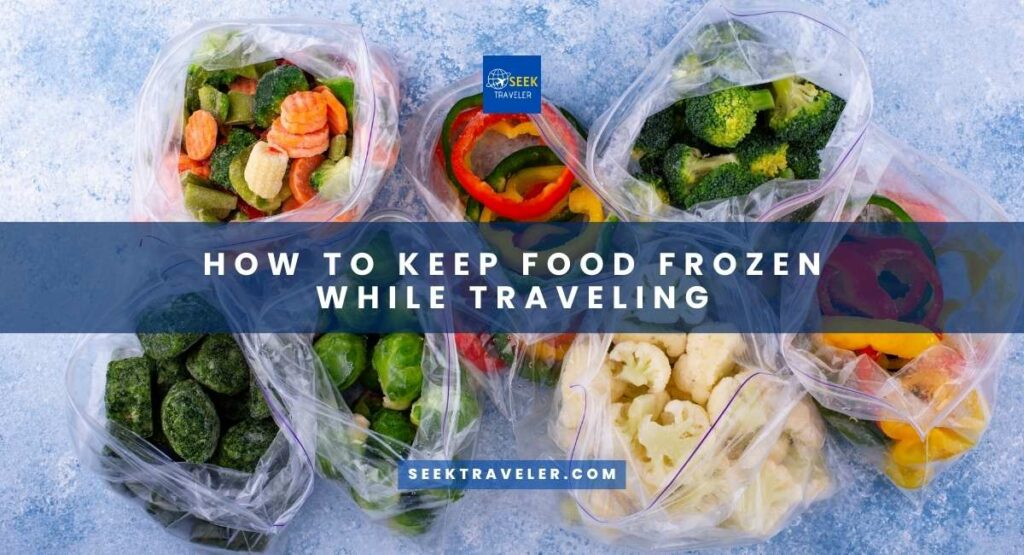As a traveler, there is nothing more satisfying than having food and drinks that are fresh and ready to consume at any time during your trip. However, keeping your perishable items frozen or chilled can be a daunting task, especially if you don’t have access to a refrigerator. The last thing you want on your adventure is stale food or warm beverages. But fear not! In this article, I’ll share with you some tips and tricks on how to keep food frozen while traveling so that you can enjoy the freedom of exploring without worrying about your sustenance.
Picture this: it’s a scorching hot day in the middle of summer, and you’re hiking up a mountain trail with sweat pouring down your face. Suddenly, hunger pangs hit you hard, and all you can think about is grabbing an ice-cold drink from your cooler waiting for you back at basecamp. You reach into your cooler only to find that everything inside has turned into mushy messes because they weren’t kept cool enough.
Don’t let this situation happen to you! With these simple steps I’m about to share with you, keeping food frozen while traveling will be as easy as pie (pun intended).
Choose the Right Cooler or Portable Fridge
You’ll want to pick the perfect cooler or fridge for your journey, one that will keep your goods cold and fresh throughout the trip. When choosing a cooler or portable fridge, there are several factors to consider.
First, you need to think about energy efficiency. Look for coolers with thick insulation and tight-fitting lids that can keep the cold air inside. This way, you won’t have to worry about constantly draining your car battery just to keep your food frozen.
Another important factor is budget-friendly options. You don’t have to break the bank just to get a good quality cooler or fridge. There are plenty of affordable options out there that can still do the job well. Just make sure you read reviews and compare prices before making a purchase.
Lastly, consider how much space you’ll need for your food and drinks. If you’re traveling with a large group or planning on being away for an extended period of time, it might be worth investing in a larger capacity cooler or fridge. On the other hand, if you’re only going on a short trip with just a few people, a smaller option might suffice.
When it comes down to it, choosing the right cooler or portable fridge is crucial when trying to keep your food frozen while traveling. Once you’ve made your selection, it’s time to move onto our next step: pre-freezing your food and drinks!
Pre-Freeze Your Food and Drinks
Before hitting the road, make sure your edibles are as solid as a rock by giving them plenty of time in the freezer. Pre-freezing your food and drinks has numerous benefits that can come in handy for a long trip.
First and foremost, it ensures that all perishables you take with you remain fresh throughout the journey. Additionally, pre-frozen items help keep your cooler or portable fridge colder for longer periods, which means you can spend more time on the road without worrying about spoilage.
To get started with pre-freezing, follow these tips for bulk freezing:
- Use high-quality freezer bags or vacuum-sealed containers to prevent any air from coming into contact with your food.
- Label each package clearly with contents and date to help keep track of what’s inside and when it was frozen.
- Consider portioning out meals or snacks ahead of time to make packing easier later on.
Pre-freezing is a vital step in preparing for any long-distance travels. Not only does it save space in your cooler or portable fridge, but it also saves time and money on buying ice along the way. Take advantage of this simple yet effective technique to ensure maximum preservation of all your favorite foods while traveling.
Now that we’ve covered pre-freezing tips, let’s move onto another important aspect of keeping food frozen while traveling: using ice packs or dry ice.
Use Ice Packs or Dry Ice
I want to talk about using ice packs and dry ice as a way to keep your food and drinks cold while traveling. There are some important differences to consider when choosing between the two. While ice packs can be convenient and easy to use, dry ice requires more caution when handling due to its extreme cold temperature.
In this discussion, I’ll also cover some tips on how to safely handle dry ice so you can enjoy your chilled items without any mishaps.
Ice Packs vs Dry Ice
If you opt for dry ice instead of ice packs, be sure to handle it carefully as it can be dangerous if not properly managed. Dry ice is a frozen form of carbon dioxide that can keep your food frozen for a longer period than regular ice packs. However, there are pros and cons to using both options.
Firstly, let’s talk about cost effectiveness. Ice packs are generally cheaper and more readily available at supermarkets or online stores. On the other hand, dry ice can be more expensive and requires special handling due to its hazardous nature.
Secondly, while both options will keep your food cold, dry ice may freeze items such as fruits or vegetables making them hard to eat straight away once they thaw out.
Lastly, consider the length of your trip and how much space you have in your cooler – if you need a longer-lasting solution then dry ice might be the better option but if you only need a few hours then an ice pack would suffice.
When it comes to keeping food frozen while traveling with dry ice, safety is key. It is important to remember that direct contact with skin or ingestion can result in serious injury or even death due to its extremely low temperature (-109°F/-78°C). To safely handle dry ice: wear gloves when handling it; use tongs or a towel when picking up pieces; store in a well-ventilated area as it releases carbon dioxide gas which can displace oxygen resulting in suffocation; never put it in an airtight container; dispose of any remaining pieces by letting them evaporate outside (never down the sink or toilet).
By following these guidelines, you’ll be able to enjoy your frozen goods on-the-go without putting yourself or others at risk.
How to Safely Handle Dry Ice
Handling dry ice safely is crucial, as it can pose serious risks such as injury or even death due to its extremely low temperature. When handling dry ice, safety precautions must be taken at all times. It’s important to wear gloves and protective eye gear when handling dry ice. This will protect your skin and eyes from the extreme cold temperatures of the dry ice.
In addition to wearing protective gear, proper storage options should also be considered when transporting food with dry ice. Dry ice should never be stored in an airtight container or sealed plastic bag, as it will cause pressure buildup that can result in an explosion. Instead, store your dry ice in a well-ventilated cooler or insulated container with vents to allow for proper airflow.
By taking these safety measures and considering proper storage options, you can ensure a safe and successful journey while using dry ice to keep your food frozen on the go. Now let’s talk about how to organize your items strategically for maximum efficiency during travel.
Organize Your Items Strategically
When I’m traveling with frozen and non-frozen items, it’s important for me to keep them separated. That way, the frozen items stay at their optimal temperature and don’t accidentally thaw out.
Additionally, I pack everything tightly so that there’s less room for things to shift around during transit. Finally, I always make sure to place my ice packs on top of everything else in my cooler or insulated bag. This ensures that they’re in direct contact with the most vulnerable areas of my food supply.
Keep Frozen and Non-Frozen Items Separated
To make sure your ice cream stays just as creamy as when you packed it, remember to separate your frozen and non-frozen items. This is one of the most important tips for packing a cooler efficiently while traveling.
When we go on road trips, we often pack everything into one big cooler without much thought to organization. However, keeping frozen and non-frozen items separated can help maintain the temperature of each item and prevent cross-contamination.
There are benefits of meal prepping that come in handy during long trips too! I like to pre-cook meals that can be reheated over a campfire or on a portable stove. By doing this, I don’t have to worry about thawing raw meat or preparing complex dishes while on the road.
Plus, having meals ready-to-go saves time and money since I don’t have to stop at restaurants along the way. With all my food organized and separated properly, it’s now time to pack items tightly into the cooler for maximum efficiency.
Pack Items Tightly
Packing items tightly in the cooler is like putting together a puzzle, each piece fitting snugly into place to create an efficient and organized space for your supplies.
Before I even begin packing, I always vacuum seal any frozen food items. This not only eliminates extra air that can take up valuable space, but it also helps keep the food fresh for longer periods of time. It’s important to check airline regulations before traveling with vacuum sealed items, as some airlines have restrictions on them.
Once all vacuum sealed items are packed, I move on to the non-frozen items. It’s crucial to pack these tightly so they don’t shift around during travel and potentially damage the frozen goods. I try to use every inch of space available and fill any gaps with smaller items such as condiment packets or utensils.
Finally, it’s important to place ice packs on top of everything in the cooler before closing it up for travel. This ensures that cold air circulates throughout the cooler evenly and keeps everything at optimal temperatures during transit without having any melted water interfere with my packing job.
Place Ice Packs on Top
Ensuring optimal temperatures during transit can be achieved by strategically placing ice packs on top of your tightly packed items in the cooler. Not only does this help keep the food frozen, but it also prevents any unwanted leaking from the ice packs.
I highly recommend using reusable ice packs as they’re not only more environmentally friendly but also hold their temperature longer than traditional ice blocks. If reusable ice packs aren’t available, there are alternatives to keeping your food frozen while traveling.
One option is to freeze bottles of water and place them on top of your food items. This will not only keep your food cold but also provide you with drinking water as they thaw out over time. Another option is to use dry ice, but this should be handled with care and caution as it can cause severe burns if touched directly.
To avoid opening your cooler or portable fridge too often, plan ahead and pack everything you need for a meal together in one container or bag. This way, you can quickly grab what you need without having to rummage through everything else in the cooler or fridge.
Avoid Opening Your Cooler or Portable Fridge Too Often
If you fancy a warm and soggy sandwich, then by all means, open your cooler every five minutes. But if you want to keep your food frozen while traveling, it’s best to avoid opening your cooler or portable fridge too often.
Every time you open the lid, you’re letting out cold air and allowing warm air to enter, which can cause the temperature inside the container to rise.
To minimize the amount of times you need to open your cooler or portable fridge, make sure everything is organized before you start your trip. Pack items that need to be kept frozen in one section and those that don’t require freezing in another. This way, when you need something from the non-frozen section, you won’t have to rummage through everything else.
Another tip for keeping food frozen while traveling is to use insulation. Benefits of vacuum sealing aside, insulating your cooler or portable fridge with materials like foam board or reflective bubble wrap can help maintain a consistent temperature inside.
Just make sure not to overfill the container with insulation because this can also reduce airflow and prevent proper cooling.
Keep Your Cooler or Portable Fridge in a Cool Place
To prevent your snacks from turning into a mushy mess, stash your cooler or portable fridge in a shaded spot where the sun can’t beat down on it. This will help maintain a lower temperature inside and keep your food frozen for longer periods. Additionally, you can benefit from insulation by placing blankets or towels over the cooler to add an extra layer of protection against heat.
Here are some cooling techniques for extreme temperatures that you can use to keep your food frozen while traveling:
- Freeze water bottles and place them in the cooler with your food items. This will help maintain a colder temperature without adding any additional weight.
- Use dry ice instead of regular ice cubes to keep your food frozen for days at a time.
- If possible, park your vehicle in a shaded area or under trees to reduce the amount of direct sunlight shining on your cooler or portable fridge.
- Consider purchasing a battery-powered fan to circulate cool air inside the cooler.
- Keep track of the temperature using a thermometer to ensure it remains below 40°F.
By following these tips, you can ensure that your food stays frozen and fresh even during long road trips.
Next, we’ll discuss how monitoring the temperature is crucial for keeping everything chilled on-the-go.
Monitor the Temperature
Make sure you’re keeping an eye on the temperature inside your cooler or portable fridge, so that everything stays as cool as a cucumber during your journey. Temperature monitoring is crucial when traveling with frozen food. Not only does it ensure that your food stays at the right temperature, but it also prevents bacteria growth and spoilage.
The benefits of temperature monitoring are numerous. For one, it helps maintain the quality of your frozen food by preventing freezer burn and ice crystals from forming. Additionally, consistently low temperatures prevent bacterial growth and keep your food safe to eat for longer periods of time. By ensuring that your cooler or portable fridge maintains a consistent temperature, you can have peace of mind knowing that you’re consuming fresh and healthy meals while on the go.
Maintaining a consistent temperature is paramount when traveling with frozen food. Fluctuations in temperature can lead to spoilage and wasted food. To ensure consistency throughout your journey, keep an eye on the thermometer inside your cooler or portable fridge and adjust accordingly if necessary.
With careful attention to detail, you can enjoy delicious frozen meals even miles away from home. As important as it is to monitor the temperature of your cooler or portable fridge while traveling with frozen foods, disposing of them properly is equally essential to maintaining freshness and avoiding waste.
Let’s explore some simple ways to dispose of any leftover items safely before we continue our journey towards adventure!
Dispose of Food Properly
Don’t forget to properly dispose of any uneaten items from your cooler or portable fridge, as this will help maintain cleanliness and avoid unpleasant odors during your journey. Proper food disposal is essential when traveling with perishable items.
If you’re on a road trip or camping adventure, it’s important to keep the environment in mind and dispose of your food properly. Improper food disposal can have a significant impact on the environment. Food waste that ends up in landfills produces harmful gases like methane, which contributes to climate change. Additionally, wildlife can be negatively affected by discarded food.
Animals may become sick from consuming spoiled or contaminated items, leading to further environmental issues. To avoid these problems, make sure you plan ahead for proper food disposal while traveling. Keep a trash bag handy in your vehicle and dispose of any uneaten items at designated rest stops or other appropriate locations along your route.
Take care not to litter and always follow Leave No Trace principles when disposing of waste outdoors. By responsibly disposing of your uneaten food while traveling, you’ll not only maintain cleanliness and avoid unpleasant smells but also do your part in protecting the environment for future generations to enjoy. Remember: leave only footprints and take only memories!
Frequently Asked Questions
How long can food stay frozen in a cooler or portable fridge?
I’m a big fan of summer road trips! But let’s face it, keeping food frozen while traveling can be a challenge.
Luckily, I’ve picked up some tips for efficient cooling along the way. First things first: choosing the right cooler is key for longer freezing times. Look for models with thick walls and lids that seal tightly to keep cold air in and warm air out.
Additionally, try pre-chilling your cooler before packing it with frozen items to jumpstart the cooling process. And don’t forget to layer ice packs between your frozen foods to keep everything evenly chilled.
With these tricks up my sleeve, I’ve kept my food frozen for up to five days on the go!
Can you use regular ice instead of ice packs or dry ice?
Using regular ice to keep food frozen while traveling may seem like a cost-effective option, but it comes with both pros and cons. On the one hand, regular ice is easy to find at most gas stations and grocery stores, making it a convenient choice for last-minute packing. It also doesn’t require any special containers or handling procedures.
However, on the other hand, regular ice melts quickly and can create a mess in your cooler or portable fridge. Additionally, as the ice melts, it can introduce moisture into your food packaging, potentially leading to bacterial growth and spoilage.
Overall, while using regular ice may be an option in a pinch, it’s not the most reliable method for long-term travel or storing perishable foods safely.
What is the difference between ice packs and dry ice?
Dry ice and regular ice packs are two popular ways of keeping food frozen. While dry ice is more efficient in freezing food, it can be dangerous if not handled properly as it releases carbon dioxide gas which can cause suffocation in poorly-ventilated areas.
On the other hand, ice packs are a safer option and can keep your food cold for up to 24 hours, making them perfect for short trips. Additionally, they come in various sizes and shapes that fit any container or cooler you may have.
Overall, using ice packs is a convenient and safe way to keep your food frozen during travel without the risk of carbon dioxide gas exposure that comes with using dry ice.
How do you properly dispose of food from a cooler or portable fridge?
Proper food disposal is crucial for reducing our environmental impact. Did you know that the average American generates 4.4 pounds of trash per day? That’s a staggering amount of waste, and much of it ends up in landfills where it can take hundreds or even thousands of years to decompose.
When it comes to disposing of food from a cooler or portable fridge, it’s important to be mindful of how we’re impacting the environment. One easy way to do this is by composting any organic material, like fruit peels or vegetable scraps, instead of throwing them in the garbage.
Additionally, make sure any non-compostable items are disposed of properly according to local regulations. By taking these small steps, we can all do our part in reducing our environmental footprint and keeping our planet healthy for future generations.
Can you keep non-frozen items in the same cooler or portable fridge as frozen items?
When it comes to sharing space in a cooler or portable fridge, the key is organization for maximum efficiency. While it may be tempting to throw all of your food items together, frozen and non-frozen, this can lead to transportation challenges during long trips.
To keep frozen food safe, it’s important to designate a separate area for these items and ensure they are fully wrapped or contained in airtight packaging. As for non-frozen items, consider grouping them by type (such as drinks in one section and snacks in another) to make accessing what you need easier.
By taking the time to organize your cooler or portable fridge before hitting the road, you’ll not only keep your food safe but also free up space for any other essentials you may need while on the go.
Conclusion
In conclusion, keeping your food frozen while traveling is crucial to ensure the safety and quality of what you eat. Imagine trekking through a beautiful mountain range with only warm sandwiches and spoiled yogurt for sustenance. Not an ideal situation, right? That’s why following these tips can make all the difference.
Firstly, invest in a high-quality cooler or portable fridge that suits your needs. Picture yourself opening it up to find everything still frozen solid despite hours on the road.
Secondly, pre-freezing your food and drinks will help keep them cold for longer periods of time. Think about biting into an ice-cold apple on a hot summer day while lounging by the beach.
Using ice packs or dry ice is another essential step in ensuring your food stays frozen during travel. Just picture yourself reaching for that cold bottle of water from your cooler after a long hike in sweltering heat.
Organizing items strategically and avoiding constant opening of the cooler are also key elements to success.
Keeping your cooler or portable fridge in a cool place, monitoring temperature regularly, and disposing of any leftover food properly are additional measures you can take to guarantee freshness throughout your trip.
So next time you’re planning an adventure out into the wilderness or simply taking a road trip with friends, remember these tips to keep your food frozen and enjoy every bite!

Meet Michael Graham, the main author of SeekTraveler.com. With a wanderlust that knows no bounds, Michael has traversed more than 30 countries across the globe. From sun-soaked Caribbean islands to the ancient marvels of Europe and the captivating charm of Japan, he has witnessed the wonders of diverse cultures firsthand. Michael’s in-depth knowledge and contagious enthusiasm for travel will inspire you to pack your bags and embark on your own extraordinary journey.



